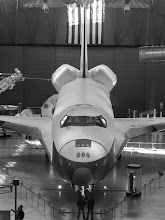Recently, I watched Pam Moran’s TEDx talk titled “Tomorrow is Today.” I found this inspiring talk via Jonathan Martin’s blog recommendation. I was motivated to view the talk in part because of his, but also as a space policy wonk (I have a MA from George Washington University in Space Policy) I was curious about the parallels Moran draws between NASA and the current state of our education system.
First, as a STEM and robotics teacher, I find the verbs Moran uses to describe her vision for education. Students should have access to “maker spaces” where they can learn to design, engineer, and build so that they learn to be “problem solvers not problem makers.” Her call to step away from the old Gutenberg style of education where students hear, memorize, and recall information, is spot on. Moran instead proposes a Wagner-esque, approach similar to play-passion-purpose, where inquiry allows student to learn and view problems through different lenses because there are, “no standard problems in the world.”
No standard problems; no standard solutions yet human space exploration and education parallel each other because their mutual failure to adapt and evolve is the result of ever revolving. Here there is a standard problem with a standard solution.
NASA was established when President Eisenhower signed Public Law 85-856, 72 Stat., 426 the National Aeronautics and Space Act of 1958. This law created a civilian space agency with the purpose of “providing for the research into problems of flight within and outside the earth’s atmosphere.” Section 102 of the law actually contains 8 items with subparts clearly outlining the purpose and policy for the agency. Nowhere is NASA charged with deep space exploration. The grand challenge of sending humans to the moon was a direct and purposeful component of President John F. Kennedy’s foreign policy objective to win the hearts and minds of peoples around the globe. The goal: demonstrate that America and democracy were superior to communism by daring to do something so great that it would stand as the achievement against which all endeavors were measured.
Kennedy’s lunar program succeeded where other President’s exploration programs have foundered in Washington bureaucratic politics because of his repeated and visible commitment to the moon program. In the 1960s it was simply un-American to be against landing that first human on the moon. In the 41 years since the last Apollo mission, presidential administrations have issued their space policies and established different visions for space exploration, but even the most successful programs, the space shuttle and space station, have left NASA trapped in low earth orbit flying laps around our planet. Agency engineers and leaders who were inspired as children to build their own rockets with Erector sets wish to reach for more, to restore the excitement, and energy to the space program. Yet, NASA, like education lacks a consistent vision and sustainable architecture/road map forward.
The American republic is a fascinating organism. Every two –to- four years we have a controlled revolution. Even in years like 2012 when the incumbent President retains the White House his entire cabinet and the executive agency administrators and directors resign. Some of the leaders are asked to return for the second term, but NASA and the Department of Education could likely see new leadership, bringing about a change in approach to the administration’s policy. This is not a sustainable path forward for either program. The policies, philosophies, and architectures guiding education and space exploration must endure beyond election cycles and changes of leadership at most local levels.
If education is to find a path forward to meet, as Moran said, “the grand challenge transforming education so that it is reflective of the world our students will meet in the future,” education must adopt a Kennedy-esque approach. The vision must be clear. The vision must be repeated. To be successful, “we must own the vision together.” Failure to do so will leave our students trapped in the low orbit of the Gutenberg era of education.
It's a Small World... Don't Burn Bridges
14 years ago




